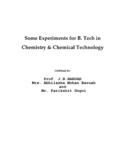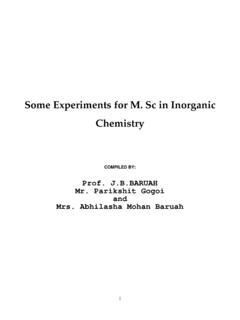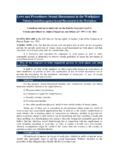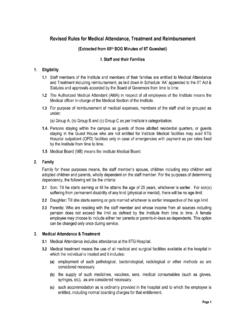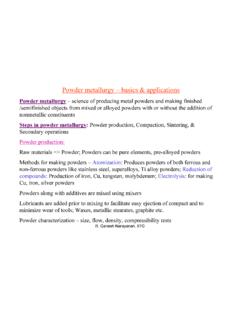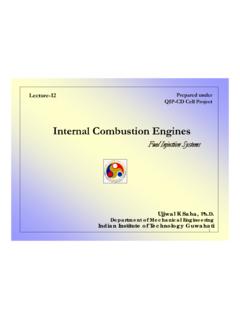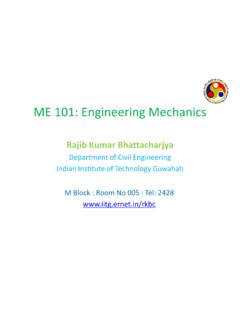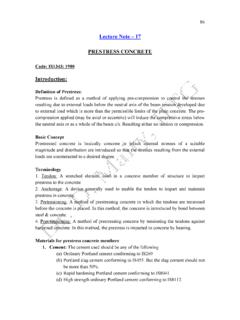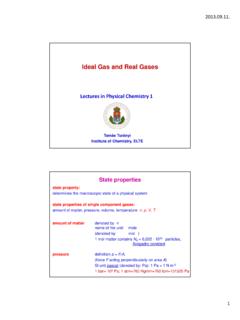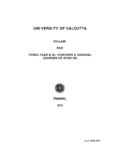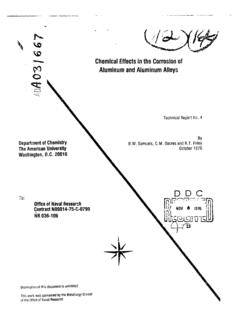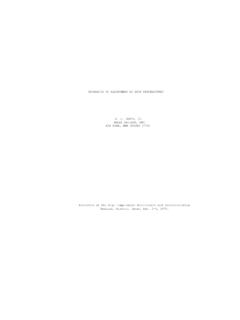Transcription of Refinery Process Design - iitg.ac.in
1 Refinery Process Design (Lecture notes ) Dr. Ramgopal Uppaluri Department of Chemical Engineering Indian Institute of Technology Guwahati North Guwahati 781039, Assam, India March 2010 Acknowledgements From my mature childhood, I always had a very passionate desire to venture into slightly newer areas and explore my professional capabilities in these fields. This passionate desire fructified after I met Dr. T. D. Singh (Founding Director, Bhaktivedanta Institute), a grand visionary for the synthesis of science spirituality. His exemplary life, dedication to the mission day and night always inspired me to set difficult to address targets in life and achieve them. Apart from my fundamental interests in science spirituality which is my first exploration away from Process engineering professional life, Refinery Process Design is my second intellectual offshoot. The foremost acknowledgement for the Lecture notes goes to the Almighty God, who provided me the desired intelligence and attributes for delivering the Lecture notes .
2 Next acknowledgement for the Lecture notes goes to the Department of Chemical Engineering, IIT Guwahati which has been my professional father and mother in which I am there for the past six years enjoying my every moment in personal as well as professional activity. IIT Guwahati has truly inspired me to write the Lecture notes due to variety of reasons. To name a few, the early heat exchanger network consultancy projects conducted with IOCL Guwahati and BRPL Bongaigaon have been pretty useful to develop insights into the nature of Refinery processes and streams. The ideal setting of IIT Guwahati in the midst of petroleum refineries really inspired me to deliver the lecture notes for professional usage too! The third acknowledgement goes to the Centre for Educational Technology (CET), IIT Guwahati for providing seed funding towards the preparation of the Lecture notes . The seed funding enabled me to enhance the quality of the book to a large extent ranging from calculations to correlation data tables etc.
3 I am highly thankful to Prof. R. Tiwari and Prof. S. Talukdar for providing me this worthy opportunity. The next acknowledgement goes to my students Ms. Anusha Chandra for assisting in the Refinery property estimation and Mr. Vijaya Kumar Bulasara for assisting in all CDU calculations! Their patience and commitment really inspired me to take up the challenge in difficult circumstances. Mr. Ranjan Das, my graduating student also needs to be acknowledged for generating the data tables for good number of correlations which are essential for the calculations. Finally, I wish to acknowledge my mother and father, as they have been the fulcrum of my continued pursuits in chemical engineering practice for the past fifteen odd years. Last but not the least I acknowledge my wife whose patience and support during long hours I dedicated for the development of the lecture notes is very much appreciated. Date: 16th March 2010 (Dr.)
4 Ramgopal Uppaluri) IIT Guwahati ii Preface To draft the lecture notes in the specialized topic of Refinery Process Design needs expertise in both fields of petroleum refining and Process Design . The basic urge of extending my Process Design specific skills to the Design of petroleum refineries started in IIT Guwahati, and specifically after thoroughly reading Jones and Pujado (2006) book which I feel should be the primary reference for Refinery Design . The primary objective of the lecture notes is to provide a very simple and lucid approach for a graduate student to learn upon Design principles. While Jones and Pujado (2006) summarized many calculations in the form of Tables, for better explanations I always felt that calculations should be conducted and explained as well. With this sole objective I drafted the Lecture notes . Consisting of three main chapters, this lecture notes enables a graduate chemical engineer to learn all necessary content for maturing in the field of Refinery Process Design .
5 In the very first chapter, a very introductory issue of relating the subject matter of Refinery Process Design to conventional chemical Process Design is presented from a philosophical perspective. Thereby, the second chapter presents a detailed discussion of the estimation of essential Refinery stream properties. The third chapter attempts to provide a new approach for conducting Refinery mass balances using the data base provided by Maples (2000). The fourth chapter deliberates upon the Design of crude distillation unit with further elaborates towards the selection of complex distillation reflux ratio, pump around unit duty estimation and diameter calculations. All in all, the lecture notes did not present some elementary Design related chapters pertaining to the Design of heat exchanger networks, Design of light end units and Design of Refinery Process absorbers. These will be taken up in the subsequent revisions of the Lecture notes .
6 I hope that this lecture notes in Refinery Process Design will be a useful reference for both students as well as practicing engineers to systematically orient and mature in Process Refinery specialization. Date: 16th March 2010 (Dr. Ramgopal Uppaluri) IIT Guwahati iii Dedication To Dr. T. D. Singh Founder Director, Bhaktivedanta Institute Short biography of Dr. T. D. Singh: Dr. T. D. Singh received his in Physical Organic Chemistry from the University of California at Irvine, USA in 1974. He was a scientist and spiritualist well known for his pioneering efforts in the synthesis of science and religion for a deeper understanding of life and the universe. He was trained in Vaishnava Vedanta studies from 1970 to 1977 under Srila A. C. Bhaktivedanta Swami and was appointed Director of the Bhaktivedanta Institute in 1974. He organized four major International conferences on science and religion First and Second World Congress for the Synthesis of Science and Religion (Mumbai, 1986 & Kolkata, 1997), First International Conference on the Study of Consciousness within Science (San Francisco, 1990) and Second International Congress on Life and Its Origin (Rome, 2004).
7 Collectively thousands of prominent scientists and religious leaders including several Nobel Laureates participated. He authored and edited more than a dozen books including What is Matter and What is Life? (1977), Theobiology (1979), Synthesis of Science and Religion: Critical Essays and Dialogues (1987) and Thoughts on Synthesis of Science and Religion (2001). He was also the founder Editor in Chief for two journals of the Bhaktivedanta Institute. iv Contents 1 Introduction 1 Introduction 1 Process Design Vs Process Simulation 1 Analogies between Chemical & Refinery Process Design 2 Refinery Property Estimation 3 2 Estimation of Refinery Stream Properties 5 Introduction 5 Estimation of average temperatures 7 Estimation of average oAPI and sulfur content 12 Psuedo component concept 12 Estimation of average oAPI and % sulfur content 15 Characterization factor 17 Molecular weight 21 Viscosity 21 Enthalpy 22 Vapor pressure 36 Estimation of Product TBP from crude TBP 36 Estimation of product specific gravity and sulfur content 44 Estimation of blend viscosity 58 Flash point estimation and flash point index for blends 61 Pour point estimation and pour point index for blends 63 Equilibrium flash vaporization curve 66 Summary 68 3 Refinery Mass Balances 69 Introduction 69
8 Refinery Block diagram 69 Refinery modeling using conceptual black box approach 78 Mass balances across the CDU 79 Mass balances across the VDU 81 Mass balances across the Thermal Cracker 84 Mass balances across HVGO hydrotreater 88 Mass balances across LVGO hydrotreater 91 v Mass balances across the FCC 93 Mass balances across the Diesel hydrotreater 97 Mass balances across the kerosene hydrotreater 99 Naphtha consolidation 101 Mass balances across the reformer 103 Mass balances across the naphtha hydrotreater 106 Mass balances across the alkylator and isomerizer 109 Mass balances across the gasoline pool 112 Mass balances across the LPG, Gasoil and fuel oil pools 117 Summary 120 4 Design of Crude Distillation Column 121 Introduction 121 Architecture of Main and Secondary Columns 124 Design aspects of the CDU 126 Mass balances across the CDU and flash zone 128 CDU mass balance table 142 Flash zone mass balance table 143 Estimation of flash zone temperature 144 Estimation of draw off stream temperatures 147 Estimation of tower top temperature 150 Estimation of residue product stream temperature 152 Estimation of side stripper products temperature 154 Total Tower energy balance and total condenser duty estimation 156 Estimation of condenser duty 157 Estimation of Overflow from Top tray 159 Verification of fractionation criteria 160 Estimation of Top and Bottom Pump Around Duty 173 Estimation of flash zone liquid reflux rate 177 Estimation of column diameters 179 Summary 182
9 References 183 vi List of Figures Figure TBP Curve of Saudi heavy crude oil. 5 Figure o API Curve of Saudi heavy crude oil. 5 Figure Sulfur content assay for heavy Saudi crude oil. 6 Figure Illustration for the concept of pseudo component. 12 Figure Probability chart developed by Thrift for estimating ASTM temperatures from any two known values of ASTM temperatures. 38 Figure Summary of prominent sub Process units in a typical petroleum Refinery complex. 72 Figure Refinery Block Diagram (Dotted lines are for H2 stream). 75 Figure A Conceptual diagram of the crude distillation unit (CDU) along with heat exchanger networks (HEN). 122 Figure Design architecture of main and secondary columns of the CDU. 123 Figure Envelope for the enthalpy balance to yield residue product temperature. 151 Figure Heat balance Envelope for condenser duty estimation. 158 Figure Envelope for the determination of tower top tray overflow.
10 159 Figure Energy balance envelope for the estimation of reflux flow rate below the LGO draw off tray. 166 Figure Heat balance envelope for the estimation of top pump around duty 174 Figure Heat balance envelope for the estimation of flash zone liquid reflux rate. 177 vii List of Tables Table Analogies between chemical and Refinery Process Design 2 Table Tabulated Maxwell s correlation data for the estimation of mean average boiling point (Adapted from Maxwell (1950)). 8 Table Tabulated Maxwell s correlation data for the estimation of weight average boiling point (Adapted from Maxwell (1950)). 9 Table Tabulated Maxwell s correlation data for the estimation of molal average boiling point (Adapted from Maxwell (1950)). 10 Table Characterization factor data table (Developed from correlation presented in Maxwell (1950)). 19 Table Molecular weight data table (Developed from correlation presented in Maxwell (1950)).
